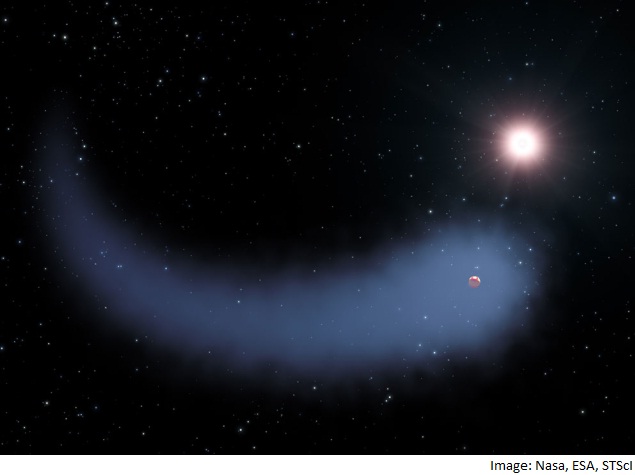- Home
- Science
- Science News
- Nasa's Hubble Telescope Spots Hydrogen Cloud Around Exoplanet
Nasa's Hubble Telescope Spots Hydrogen Cloud Around Exoplanet

Such a phenomenon not only helps explain the formation of hot and rocky 'super-earths', but also may potentially act as a signal for detecting extrasolar oceans, the study said.
"Escaping gas has been seen in the past for larger gas giant exoplanets, so it was a surprise that looking at a much smaller planet resulted in such a big and stunning comet-like display," said study co-author David Sing, professor at University of Exeter in Britain.
With a mass approximately 23 times that of our Earth located 33 light years away, the exoplanet GJ436b rotates around its star in only three days and has an atmosphere which leaves behind a gigantic trail of hydrogen.
The scientists were able to see this hydrogen cloud's shadow when it passes in front of the star.
GJ436b resides very close to its star less than two million miles and whips around it in just 2.6 Earth days. In comparison, the Earth is 93 million miles from our sun and orbits it every 365.24 days.
"This cloud of hydrogen is very spectacular!" said David Ehrenreich of the Observatory of the University of Geneva in Switzerland, lead author of the study. "Although the evaporation rate doesn't threaten the planet right now, we know that the star, a faint red dwarf, was more active in the past. This means that the planet's atmosphere evaporated faster during its first billion years of existence. Overall, we estimate that it may have lost up to 10 percent of its atmosphere."
The team's results are presented in the journal Nature.
Written with inputs from IANS
Get your daily dose of tech news, reviews, and insights, in under 80 characters on Gadgets 360 Turbo. Connect with fellow tech lovers on our Forum. Follow us on X, Facebook, WhatsApp, Threads and Google News for instant updates. Catch all the action on our YouTube channel.
Related Stories
- Samsung Galaxy Unpacked 2025
- ChatGPT
- Redmi Note 14 Pro+
- iPhone 16
- Apple Vision Pro
- Oneplus 12
- OnePlus Nord CE 3 Lite 5G
- iPhone 13
- Xiaomi 14 Pro
- Oppo Find N3
- Tecno Spark Go (2023)
- Realme V30
- Best Phones Under 25000
- Samsung Galaxy S24 Series
- Cryptocurrency
- iQoo 12
- Samsung Galaxy S24 Ultra
- Giottus
- Samsung Galaxy Z Flip 5
- Apple 'Scary Fast'
- Housefull 5
- GoPro Hero 12 Black Review
- Invincible Season 2
- JioGlass
- HD Ready TV
- Laptop Under 50000
- Smartwatch Under 10000
- Latest Mobile Phones
- Compare Phones
- Honor Win RT
- Honor Win
- Xiaomi 17 Ultra Leica Edition
- Xiaomi 17 Ultra
- Huawei Nova 15
- Huawei Nova 15 Pro
- Huawei Nova 15 Ultra
- OnePlus 15R
- Asus ProArt P16
- MacBook Pro 14-inch (M5, 2025)
- OPPO Pad Air 5
- Huawei MatePad 11.5 (2026)
- Xiaomi Watch 5
- Huawei Watch 10th Anniversary Edition
- Acerpure Nitro Z Series 100-inch QLED TV
- Samsung 43 Inch LED Ultra HD (4K) Smart TV (UA43UE81AFULXL)
- Asus ROG Ally
- Nintendo Switch Lite
- Haier 1.6 Ton 5 Star Inverter Split AC (HSU19G-MZAID5BN-INV)
- Haier 1.6 Ton 5 Star Inverter Split AC (HSU19G-MZAIM5BN-INV)

















